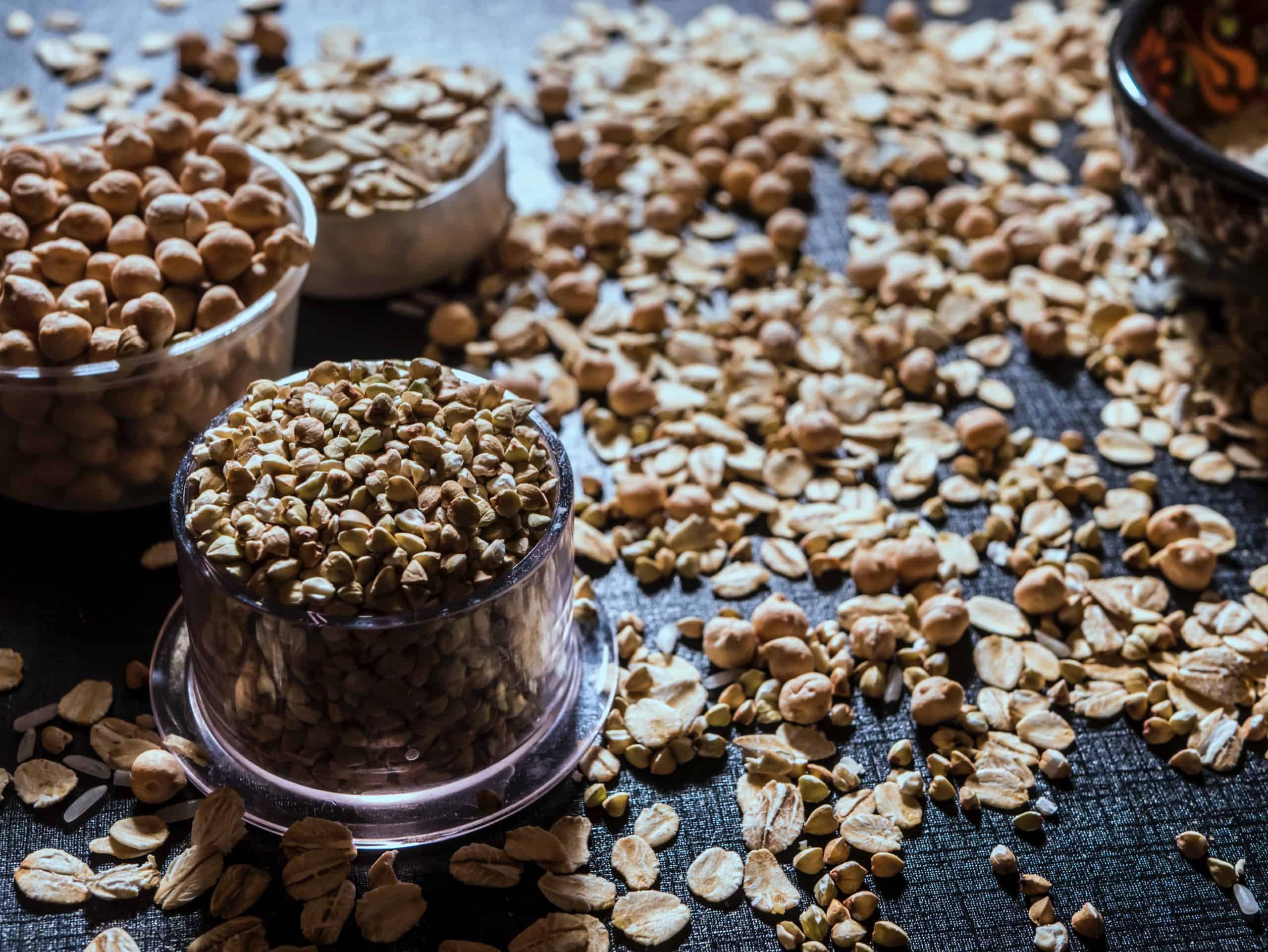What you’ll learn:
- Potatoes are nutrient-dense and can fit into a weight loss plan when prepared healthily and eaten in moderation.
- Despite their carb-heavy reputation, potatoes are a complex carb and have fiber to keep you satiated and help you maintain steady energy levels.
- Noom categorizes all types of potatoes as “green foods,” which means they are satiating and provide essential nutrients.
From fluffy baked and creamy mashed to crunchy fries, potatoes are a versatile food almost everyone loves. While these filling root vegetables can sometimes get a bad rap from the low-carb crowd, they’re packed with nutrients like fiber, vitamins C and B6, and potassium. (Potassium in a potato?!) That’s right; a medium potato has more potassium than a banana, calorie for calorie. And, if you choose sweet potatoes, you’ll also get a good dose of beta-carotene.
If your goal is weight loss, how you prepare them will be key. A baked potato topped with low-calorie toppings instead of bacon, cheese, and sour cream can make a big difference in terms of how many calories you eat.
So, are potatoes good for weight loss? Potatoes can be a part of a weight-loss plan.
At Noom, we believe sustainable food choices are key to better weight management and a healthier life. That means incorporating foods you enjoy is essential to a healthy eating plan you’ll stick to. If you love potatoes, read on to learn how to include this versatile tuber in your diet.
How many calories are in a potato?
The calorie content will vary depending on the type of potato and the size. Let’s look at a typical Russet potato. If you pick up a medium-sized one (about six ounces), here’s what you’re getting in terms of nutrition:
- Calories: 164
- Protein: 4.6g
- Fat: 0.2g
- Carbohydrates: 37g
- Fiber: 4g
- Sugars: 1.9g
Keep in mind that these stats are for a potato without toppings, and they will go up as the potato’s size increases. For reference, a six-ounce potato can fit comfortably in the palm of your hand. A typical extra-large steakhouse baked potato can be three times larger than a medium potato.
How do potatoes help you lose weight?
Potatoes are considered a “green food” according to Noom’s food color system. Green foods are the least calorie-dense and/or contain the highest concentration of healthy nutrients, so they should make up a bigger portion of your diet. In particular, potatoes are a good source of vitamins, minerals, and antioxidants.
They can also really fill you up. The fiber in potatoes helps slow digestion, which can keep you satiated for extended periods. If you love potatoes, enjoy them as part of a balanced diet while still making progress towards your weight loss goals.
Here are the best ways to do it:
Real results with a personalized weight loss program
Take the quiz!

- Watch your portions. Stick to one medium potato per serving.
- Use a low-fat cooking method. Instead of frying, try baking or roasting them.
- Eat them with protein and veggies. Pair them with lean proteins like chicken or fish and veggies like broccoli or cauliflower for a balanced meal.
- Don’t peel them. Keep the skin on to add more fiber and keep you feeling full.
By making these simple swaps, you can enjoy potatoes while staying on track with a healthier diet.
Potatoes vs. sweet potatoes: Which is healthier?
Both white potatoes and sweet potatoes can be valuable additions to your diet. Let’s compare how these two popular vegetables stack up in terms of calories, fiber, and protein.
| 6-ounce Russet potato | 6-ounce sweet potato | |
|---|---|---|
| Calories | 164 | 150 |
| Carbohydrates | 37 grams | 35 grams |
| Sugar | 1.9 grams | 6 grams |
| Fiber | 4 grams | 4 grams |
| Protein | 4.6 grams | 2 grams |
| Vitamin A (beta-carotene) | 0 IU | 19,000 IU |
| Vitamin C | 9 milligrams | 20 milligrams |
| Potassium | 632 milligrams | 438 milligrams |
As you can see, these types of potatoes are very similar in calorie and carb count. Sweet potatoes have a bit more sugar, but it’s naturally occurring and comes bundled with fiber and many nutrients. It’s no surprise that sweet potatoes, with their bright orange color, are higher in beta-carotene, the same vitamin you’ll find in orange carrots.
Which is best for weight loss? All types of potatoes are a high-fiber filling choice when baked or roasted.
Healthy preparation tips and recipes
Most people know how to cook with potatoes, but making them delicious and healthy is the trick for weight management. Potatoes are versatile, low-cost, and can be prepared in various ways. There are many types beyond russet and sweet potatoes—such as purple, red, and fingerling varieties—each offering unique flavors and nutrients. No matter what variety you choose, here are a few tips to lighten things up:
Healthy cooking tips for potatoes:
- Keep the skin: Bake with the skin on to retain more fiber.
- Roast with olive oil and herbs: Use a small amount of olive oil and use garlic and fresh herbs like rosemary or thyme to add flavor without extra calories.
- Choose low-fat toppings: Top with low-fat Greek yogurt and chives instead of sour cream or butter to boost protein and reduce fat.
- Use the air fryer: Try air-frying for a crispy texture without excess oil.
- Use some mashed cauliflower: For a lighter side dish, mix half mashed potatoes with mashed cauliflower for fewer carbs and calories.
- Choose sweet potatoes sometimes: They provide more vitamins, like A and C.
- Opt for steaming or boiling: These methods reduce the need for added fats while keeping the potatoes tender.
Healthy potato recipes to try
Potatoes can star in breakfast, lunch, and dinner. Here are a few creative ways to cook with potatoes throughout the day.
- Baked potato skins – This classic bar food doesn’t have to be unhealthy. Use a combo of white and sweet potatoes and top with a good sprinkle of Parmesan cheese, chopped herbs, and low-fat sour cream or Greek yogurt for a crunchy snack. (Search “baked potato skins” in Noom’s recipe tool.)
- Zucchini soup – This simple recipe uses potatoes to thicken soup instead of cream. (Search “zucchini soup” in Noom’s recipe tool.)
- Sweet potato and blueberry salad – Serve this nutritious and flavorful salad as a side, or add some grilled chicken to make it more filling for a main dish!
- Mediterranean baked sweet potatoes – Turn baked sweet potatoes into a healthy meal with chickpeas and a tasty tomato-parsley topping.
- Roasted sweet potatoes, sausage, and broccoli sheet pan meal – This veggie-packed sheet pan meal is the perfect healthy meal for busy weeknights.
- Roasted potato and creamy peanut butter salad – A creamy peanut butter dressing gives this roasted potato salad a delicious twist.
- Sweet potato protein breakfast bowl – Mash a baked sweet potato with protein powder and then top it with your favorite berry combo for a unique breakfast.
Variety is the key to a balanced and delicious diet. Be sure to use Noom’s recipe tool in your Success kit for easy, healthy recipes that are easy to track. As you can see, you can enjoy potatoes anytime when you choose healthy preparation methods and practice portion control.
Mindful eating practices
Mindful eating involves giving full attention to your food—its appearance, aroma, texture, and taste. This practice helps you savor your meals, recognize when you’re full, and make more conscious food choices.
Here are some realistic strategies to practice mindful eating with potato dishes or any other meal:
- Engage your senses: Notice the golden color of roasted potatoes, the subtle sweetness of sweet potatoes, or the creamy texture of mashed potatoes.
- Slow down: Take your time when eating. Chew slowly and pause between bites to allow your body time to signal when it’s full.
- Eliminate distractions: Turn off the TV and put away your phone to focus on your meal. This helps you stay present and enjoy the food in front of you.
- Listen to your body: Pay attention to hunger and fullness cues. Stop eating when you feel satisfied, not stuffed.
- Appreciate your food: Take a moment to feel grateful for your meal and the nourishment it provides.
Eating mindfully allows you to enjoy a reasonable portion of potatoes while supporting your weight management goals. Remember, mindfulness is about progress, not perfection. Noom’s approach to mindful eating emphasizes building sustainable habits for long-term health management.
Make potatoes a part of your weight loss plan
Potatoes can totally have a place on your plate when you prepare them right and eat them in moderation. They’re packed with vitamins and minerals, keep you feeling full, and can easily fit into a balanced diet.
The trick? It’s all about how you cook and portion them. Stick to the tips we’ve talked about—like choosing healthier cooking methods, watching your portions, and enjoying every bite—to make potatoes a tasty and satisfying part of your journey to better health.
Now, you might be wondering, “How can I make sure I’m on the right track?” That’s where Noom comes in. Our personalized approach goes beyond traditional dieting methods. Instead of labeling foods as “good” or “bad,” we help you create a balanced eating plan that includes foods you love, like potatoes, while working towards your health goals.
Noom’s recipe guides can also help you incorporate a variety of foods into your diet in a way that supports your weight loss journey. Our program goes beyond what’s on your plate—it’s about building lasting habits and fostering a healthy relationship with food.
With Noom, you’ll have the tools and guidance to support your unique weight loss goals and make informed, enjoyable food choices that you can maintain long-term.






